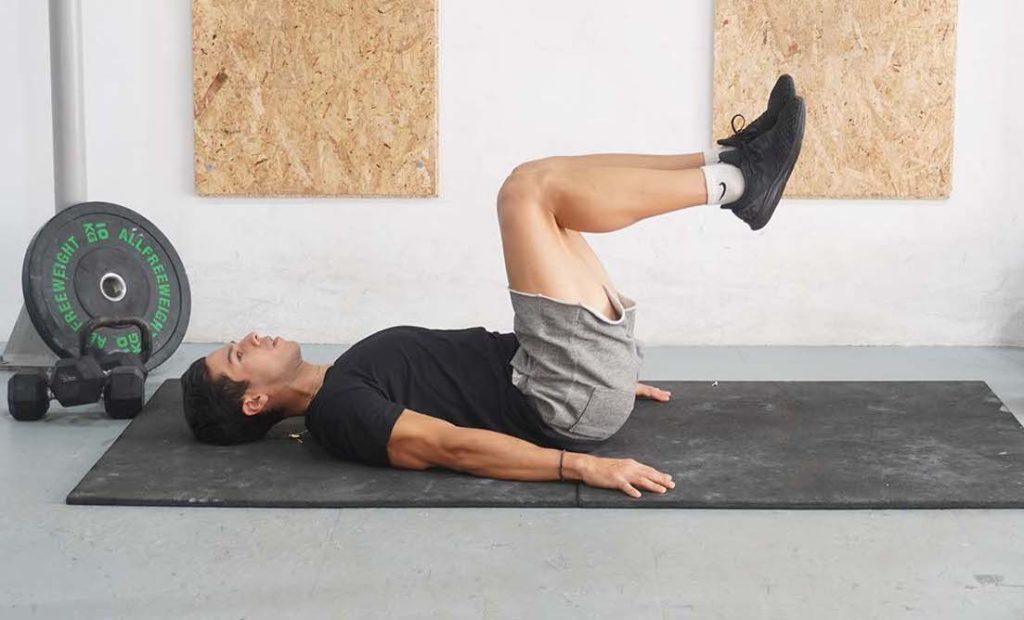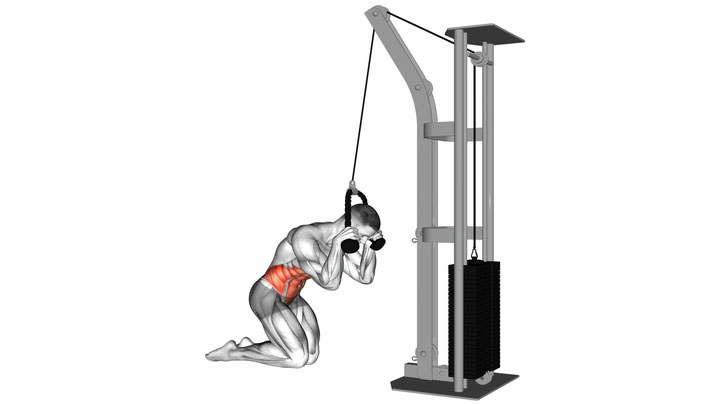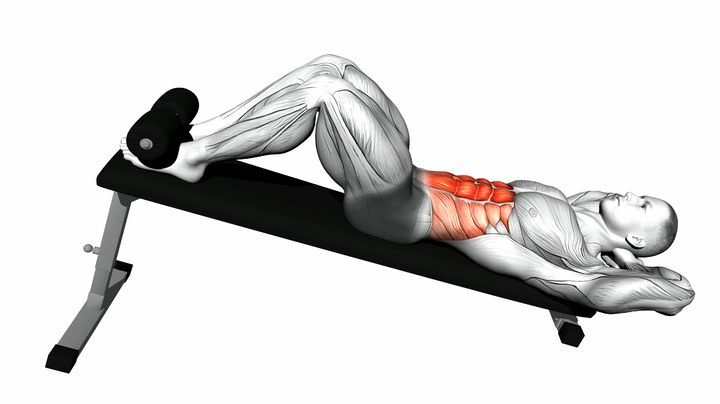What is a Vertical Knee Raise?
Vertical knee raises are among the most popular ab exercises people perform at the gym. The objective is to set yourself up inside a captain’s chair, support yourself with your upper body musculature, and repeatedly raise your knees to your torso. Doing so strengthens and develops the rectus abdominis (six-pack muscle).
A notable benefit of vertical knee raises is that the movement challenges you more than traditional crunches, sit-ups, and leg raises. Performing the activity while hanging forces more muscles to engage and keep you in position. Plus, your abs have to produce much more force to overcome gravity and raise your legs. As a result, your entire core strengthens, leading to better posture, more athleticism, and stability.
Another benefit of the movement is the fantastic overloading potential. You can start with knee raises and gradually progress to leg raises, hanging leg raises, and weighted leg raises.
The third significant benefit of vertical knee raises is that the movement involves your shoulders, chest, back, and other upper body muscles that flex isometrically to keep you in position.
We recommend including vertical knee raises near the end of your workouts, after your main lifts (squats, deadlifts, bench press, etc.). Perform as many slow and controlled reps as possible. If you want to use the movement as part of a core workout, include it earlier and while your abs are still fresh.
Level of Exercise: Intermediate
How to do a Vertical Knee Raise with Parallel Bars
- Position yourself inside a captain’s chair with your feet on a platform or steps, back against the pad, and forearms flat on the pair of padded parallel bars. Some chairs come with handles, which you should grab for extra support.
- Bring your shoulders back, engage your upper body, contract your abs, and take a breath.
- Step off the platform or steps to support yourself with your upper body musculature. Resist the urge to let your shoulders rise as your body slumps. Maintain the same position you do before stepping off.
- Once in position, take another breath and engage your abs to raise your knees as high as possible in one fluid motion. Ideally, your knees should rise to hip level or slightly more.
- Hold the top position for a moment, squeezing your abs as you do.
- Lower your knees to the starting position, extending them on the way down, and stop before your lower back begins to arch. Exhale near the bottom.
- Take another breath and raise your knees again.
What muscles does the vertical knee raise activate?
The primary muscle group that works during vertical knee raises is the rectus abdominis, which covers the stomach area and shortens the distance between the ribcage and the pelvis as it contracts (1). Engaging our abs from a hanging position allows us to raise our knees to our torso.
Our hip flexors also play a role during vertical knee raises. The collection of five muscle groups assists the abs in raising our legs, and their involvement increases if you arch your lower back (2). Doing so lengthens the rectus abdominis and prevents you from engaging the muscle group. Instead, your hip flexors take over to produce the necessary force for knee raises.
The upper back, chest, shoulders, and arms also work during vertical knee raises. The many upper body muscles flex isometrically to provide torso rigidity and keep you in position during each set.
Proper Form when Performing a Vertical Knee Raise with Parallel Bars
One of the essential tips to keep in mind for vertical knee raises is keeping your lower back flat and against the pad. As discussed in the previous point, arching your lower back causes your abs to lengthen, which prevents them from contracting and raising your knees. Maintaining a natural spine position makes it easier to engage your abs, forcing them to do most of the work.
Another tip for vertical knee raises is maintaining a solid body position from start to finish. You have to engage your entire upper body and keep your shoulder blades back before stepping off the platform or steps. Once you start the set, maintain the position for as long as possible and stop the exercise if you feel that you’re starting to lose your stability.
Our third tip is to bring your legs down until your lower back begins to arch. The point at which this happens will depend on your ab strength, and you should watch out when it occurs for you. For example, your lower back might remain against the pad to the halfway point and begin to arch as you’re three-fourths on the way down. In that case, you should stop lowering your legs then and start the next repetition. Doing so is vital for keeping constant tension on your abs and preventing your hip flexors from taking over.
Variations and Modifications of the Vertical Knee Raise
1. Vertical Leg Raise
Vertical leg raises are almost the same as knee raises, and the primary difference between the two exercises is that leg raises have you perform repetitions with your knees extended. In contrast, knee raises are about lifting your legs with your knees bent. The former is more difficult and better suited for people who find knee raises less challenging (3).
2. Lying Knee Raise

In contrast to the previous movement, lying knee raises are a beginner-friendly variation that doesn’t require any equipment. Instead of setting yourself up inside a captain’s chair, you have to lie on the floor and raise your knees to your torso.
3. Weighted Vertical Knee Raise
The weighted knee raise is a more advanced variation that further strengthens and develops your abs. One good option is to attach ankle weights before the movement. Alternatively, you can pinch a dumbbell between your feet and lift it repeatedly.
Mistakes to Avoid
Arching Your Lower Back
Arching your lower back is among the most common mistakes with knee raises and other ab movements. The issue occurs due to a lack of ab strength, which forces your pelvis to tilt forward, arching your lower back and causing your hip flexors to take over the movement. Avoid the error by keeping your lower back firmly against the pad and lowering your legs until you notice your lower back arching.
Doing Reps too Quickly
Another error with knee raises is doing reps too quickly. Trainees often rush through the movement to do more repetitions, but doing so can prevent you from getting the most out of each set. A much better approach is to slow the tempo down, feeling your abs work hard from start to finish on each rep.
Not Breathing
The third common mistake with knee raises is holding your breath during a set. Breathing while engaging your abs can be challenging, but you must maintain a steady tempo to fill your body with oxygen and perform optimally. So, breathe in, raise your knees, and exhale just as you lower your legs to the starting position.
Similar Exercises to the Vertical Knee Raise
Cable Crunch

Cable crunches are a simple and effective gym exercise you can do to strengthen your abs. A notable benefit is that you can adjust the resistance to fit your current strength level and increase the load as your abs develop.
Dead Bug
Despite its slightly unusual name, the dead bug is an effective exercise that strengthens your abs and improves muscle coordination. The objective is to lie on the floor, bend your knees, and position them over your hips. Raise your arms above your torso and take a breath. Once in position, extend your right leg as you bring your left arm back and to the side of your head. Bring your leg and arm to the starting position and extend your opposite limbs in the same way. Keep alternating until you finish the set.
Decline Crunch

Decline crunches are an effective exercise that strengthens your abs. The objective is to lie on a decline bench, anchor your feet, and contract your abs to lift your torso several inches off the back support. Performing the movement at a decline forces your abs to work extra hard.

